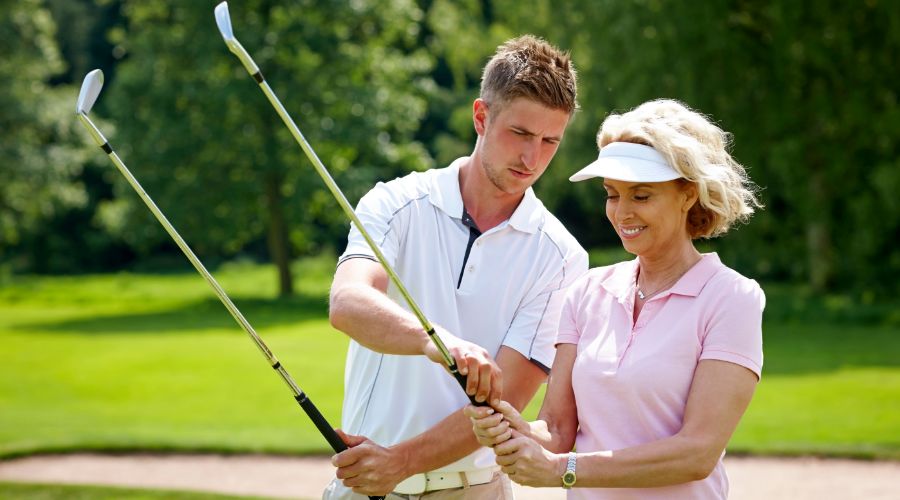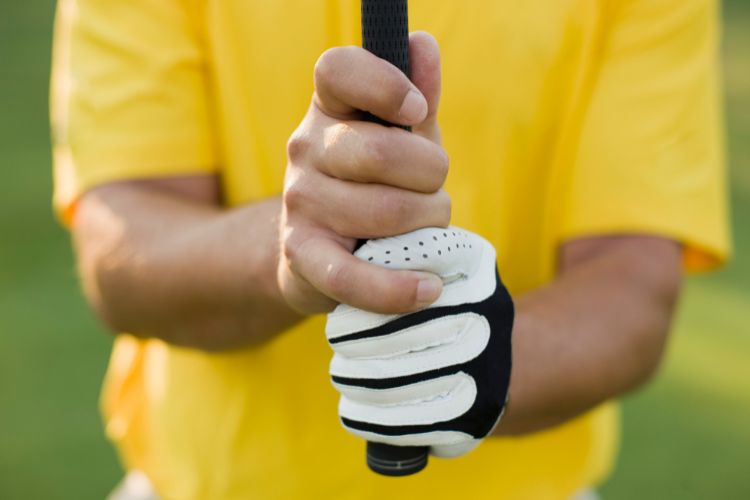How to Achieve the Proper Golf Grip
Posted by

Many beginners believe the way they hold their golf club is a minor detail. However, as any golf pro will tell you, your golf grip is one of the keys to the game. Think of your golf grip as the foundation of a house. Without a strong base, everything else will be unstable.
Mastering a golf grip can change your entire game. It might seem tricky at first, but with the proper guidance, anyone can get it right. A good grip gives you control, consistency, and confidence, and reduces the likelihood of injury.
By learning this essential skill, you can get a smoother swing and better shots. This guide provides a simple, step-by-step method to get your grip just right. Whether you’re new to golf or simply need a refresher, this easy-to-follow approach is designed for you.
Ready to perfect your golf grip? Let’s begin your journey today with personalized coaching on Skillest. Get started.
Why a Proper Golf Grip Matters
A proper golf grip plays a vital role in your golf game. It directly affects the control and accuracy of your shots. Without a proper grip, even the most skilled golfer can struggle to keep the ball on target.
Having a consistent grip helps maintain the correct swing plane. This consistency is vital for producing repeatable and reliable shots.
Moreover, a proper grip can reduce the risk of injuries. Incorrect grip pressure and hand positioning can lead to strains and other injuries over time, particularly those affecting the wrists, forearms, and back.
A good grip enables you to control the golf club’s face and, consequently, the ball’s direction. It allows you to apply the right amount of force, ensuring that the clubhead strikes the ball squarely.
This control is particularly important when tackling tricky shots, such as navigating around hazards or dealing with unstable or forceful wind conditions.
In addition to control, a proper grip provides stability. This stability is crucial for long games, where fatigue can set in.
Consistency in your grip will translate to consistency in your swing, which in turn leads to more predictable and accurate shots.
Skillest, the No. 1 sports coaching platform, highlights the importance of a proper golf grip in their training modules, which emphasize that even minor adjustments can have a significant impact on your overall performance.
Our coaches often use detailed video analyses to show how grip adjustments can lead to better shot outcomes. The Skillest approach is based on scientific principles and aims to offer golfers personalized advice for improving their grip.
A proper golf grip is foundational to your success on the course. It offers control and consistency, and reduces the risk of injury. By focusing on mastering your grip, you set yourself up for a more enjoyable and successful golfing experience.
Make sure to practice regularly and seek professional guidance when needed to fine-tune your grip.

You don't need another golf lesson. What you need is a golf coach.
Steps to Achieve the Proper Golf Grip

Achieving the proper golf grip involves several steps. Each step is crucial and builds upon the previous one.
First, take the time to select the right club, as your grip will differ slightly depending on the type of club you are using.
Second, position your left hand correctly on the club, followed by your right hand. (Note that these directions are aimed at right-handed players; if you’re left-handed, do the reverse.)
Third, pay attention to grip pressure, which is essential to avoid common mistakes.
Finally, consistent practice is key to mastering the proper golf grip.
Our coaches suggest breaking down the process into manageable chunks. The following step-by-step approach can help beginners and even seasoned players to fine-tune their grip.
Each step focuses on a specific element, ensuring that you understand and can implement the changes effectively. By following these steps, you can significantly improve your grip, leading to better performance on the course.
Step 1: Choose the Right Club
Selecting the right club is the first step in achieving a proper golf grip. Your grip might differ slightly depending on whether you are using a driver, an iron, or a putter.
Each club has a unique design and purpose, which can influence how you hold it. For example, a driver is designed for long-distance shots, requiring a grip that allows for maximum swing speed and control.
A putter is used for precision shots on the green, necessitating a more delicate and controlled grip.
Skillest coaches recommend starting with the club you feel most comfortable with. This will allow you to focus on adjusting your grip without worrying about the club’s characteristics.
As you become more confident, you can experiment with different clubs to see how your grip might need to adjust. This approach ensures that you develop a versatile grip that can handle various golfing situations.
By choosing the right club, you set the stage for crafting a proper grip.
Step 2: Position Your Left Hand
Positioning your left hand correctly on the club is the next crucial step. Your left hand should grip the club in a way that provides control and stability.
The club should rest diagonally across the base of your fingers, not in the palm. This positioning allows for the greatest control and flexibility.
Your thumb should point down the shaft, creating a “V” shape between your thumb and forefinger. The sharp end of the “V” should point toward your right shoulder (or, alternatively, toward your right ear). Check this repeatedly to ensure that your hand is in the correct position.
This step is crucial. If you focus on achieving the correct position of your left hand, the rest of the sequence will follow naturally, enabling you to improve your overall performance.
Step 3: Position Your Right Hand
Once your left hand is correctly positioned, it’s time to focus on your right hand. Your right hand should complement the position of your left hand, providing additional control and stability.
The club should rest in the base of your fingers, similar to your left hand. Your right thumb should point down the shaft, and the point of the “V” shape formed by your thumb and forefinger should also point toward your right shoulder or right ear.
Ensure that your lead thumb is down the right side of the handle and your trail thumb is down the left side.
You can use either an overlap or a 10-finger grip. An overlap grip links the pinkie on the right hand with the forefinger on the left, which some players believe provides more stability. A 10-finger grip keeps the hands separate, with all 10 fingers on the handle of the club.
By ensuring that your right hand is correctly positioned, you can achieve a more balanced and effective grip. Skillest coaches highlight the importance of this step through video tutorials and personalized feedback.
They emphasize that the right hand’s position can significantly impact your swing’s accuracy and power.
Practicing this step regularly and seeking professional guidance can help you achieve the proper grip with your right hand.
Step 4: Check Your Grip Pressure
Grip pressure is a critical element in achieving the proper golf grip.
Gripping the club too tightly can lead to tension in your hands and arms, negatively affecting your swing. On the other hand, a grip that is too loose can result in a lack of control and stability. Finding a balance is essential for optimal performance.
Our coaches recommend thinking of grip pressure like holding a tube of toothpaste. You want to hold it firmly enough to keep it from slipping but not so tightly that you squeeze the toothpaste out.
To check your grip pressure, take a few practice swings and pay attention to the way your hands feel. If you notice any tension or discomfort, adjust your grip accordingly.
Practicing this step regularly can help you develop a better sense of the appropriate grip pressure, leading to improved control and consistency in your shots.
Step 5: Practice Your Grip
Practicing your grip is the final step in achieving the proper golf grip. Consistent practice is essential for developing muscle memory and ensuring that your grip becomes second nature.
One effective way to practice your grip is to use a mirror. Stand in front of the mirror and go through the steps of positioning your hands on the club.
This visual feedback can help you identify any issues and make the necessary adjustments. Additionally, practicing with different clubs can help you develop a versatile grip that can handle various golfing situations.
Consistent practice is crucial for mastering the proper golf grip. By dedicating time to practice your grip regularly, you can develop the muscle memory needed for a consistent and effective grip. This focus on practice will ultimately lead to improved performance on the course.
Common Mistakes With Golf Grips
Even seasoned golfers can make mistakes with their golf grips. Recognizing these common mistakes is the first step toward correcting them.
Incorrect hand positioning, gripping too tightly, and ignoring grip pressure are some of the most frequent errors. By understanding these common mistakes, you can take proactive steps to avoid them and improve your grip.
Mistake 1: Gripping Too Tightly
Gripping the club too tightly is a common mistake among golfers. A tight grip creates tension in your hands, wrists, and arms, which can negatively affect your swing.
This tension can lead to a loss of control and reduced swing speed, resulting in weaker and less accurate shots.
As well as the toothpaste-tube analogy mentioned above, Skillest coaches use the analogy of holding a bird to explain the correct grip pressure. You want to hold the bird firmly enough so it doesn’t fly away, but not so tightly that you harm it.
Essentially, you want to maintain a grip that is firm enough to secure the club and ensure precision, but loose enough to allow for a free swing. The correct grip will also reduce the likelihood of injury, which is often caused by too much tension in the body during the swing.
Regularly check your grip pressure during practice sessions. Take a few practice swings and pay attention to how your hands feel. If you notice any tension or discomfort, adjust your grip accordingly.
Consistent practice and mindfulness can help you develop a more relaxed and effective grip.
Mistake 2: Incorrect Hand Position
Incorrect hand positioning is another common mistake that can impact your golf game. If your hands are not positioned correctly on the club, it can lead to issues such as slicing or hooking the ball. This mistake can make it challenging to achieve consistent and accurate shots.
Skillest coaches emphasize the importance of correct hand positioning through video tutorials and personalized feedback. They show how improper hand positioning can affect your swing and provide tips for correcting it.
One common issue is placing too much of the club in the palm of the hand rather than in the fingers. This can reduce control and flexibility.
To correct this mistake, practice positioning your hands correctly on the club. Ensure that the club rests diagonally across the base of your fingers and that your thumbs point down the shaft.
Check the V’s formed by thumb and forefinger. They should point toward your right shoulder or right ear.
Regular practice and professional guidance can help you develop better hand positioning, leading to improved performance on the course.
Mistake 3: Ignoring Grip Pressure
Ignoring grip pressure is a common mistake that can lead to inconsistent shots. As any pro will tell you, grip pressure plays a crucial role in controlling the club and achieving accurate shots.
Focus on achieving a happy medium between a tight grip and a loose one. If your grip is too tight, you may feel the tension running up your arms into your shoulders.
If your grip is too loose, you may note that the club feels floppy, which will lead to a lack of precision in the swing.
Skillest coaches often highlight the importance of grip pressure in their training modules. They use video analyses to show how improper grip pressure can affect your swing and provide personalized feedback to help you find the right balance.
Consistent practice and mindfulness can help you develop the appropriate grip pressure, leading to improved control and consistency in your shots.
Tips for Maintaining a Proper Golf Grip
Maintaining a proper golf grip requires consistent effort and practice. Regularly checking your grip, adjusting for different clubs, and practicing consistently are essential for maintaining the correct grip.
Additionally, seeking professional guidance and using tools such as mirrors and video analyses can help you fine-tune your grip and ensure that it remains effective.
Skillest coaches often provide tips and techniques for maintaining a proper golf grip. They emphasize the importance of regular practice and mindfulness, encouraging golfers to dedicate specific practice sessions to focus solely on their grip.
By following the three tips below, you can maintain a proper golf grip and improve your overall performance on the course.
Tip 1: Regularly Check Your Grip
Regularly checking your grip is essential for maintaining a proper golf grip. Over time, your grip can change due to factors such as fatigue, stress, and muscle memory. Regularly checking your grip ensures that it remains consistent and effective.
Visual feedback, such as practicing in front of a mirror, can help you identify any issues and make the necessary adjustments. Additionally, having a coach provide feedback can be invaluable in ensuring that your grip remains correct.
By regularly checking your grip, you can ensure that it remains consistent and effective. This practice helps you develop the muscle memory needed for a proper grip, leading to improved performance on the course.
Tip 2: Adjust for Different Clubs
Adjusting your grip for different clubs is crucial for maintaining a proper golf grip. Each club has a unique design and purpose, which can influence how you hold it.
For example, a driver requires a grip that allows for maximum swing speed and control, while a putter requires a more delicate and controlled grip.
Skillest coaches often highlight the importance of adjusting your grip for different clubs.
They use video analyses to show how grip adjustments can impact your performance with different clubs. By understanding how different clubs affect your grip, you can develop a versatile grip that can handle various golfing situations.
To adjust your grip for different clubs, practice with each club and pay attention to how your grip feels.
Make necessary adjustments to ensure that your grip is effective for each club. Regular practice and professional guidance can help you develop a versatile grip that can handle various golfing situations.
Tip 3: Practice Consistently
Consistent practice is essential for maintaining a proper golf grip. Regular practice helps you develop the muscle memory needed for a consistent and effective grip.
Our coaches frequently suggest dedicating specific practice sessions to focus solely on your grip. This targeted approach allows you to fine-tune your grip without the distractions of other aspects of your game.
Practicing with different clubs can help you develop a versatile grip that can handle various golfing situations. As always, the proof is in the pudding: You should be able to see an improvement in accuracy and consistency on the course once you’ve addressed the issues with your golf grip.
Consistent practice is crucial for maintaining a proper golf grip. By dedicating time to practice your grip regularly, you can develop the muscle memory needed for a consistent and effective grip. This focus on practice will ultimately lead to improved performance on the course.
Conclusion: Mastering the Proper Golf Grip
Mastering the proper golf grip is essential for success on the course. A proper grip offers control and consistency, and reduces the risk of injury.
By following a step-by-step approach and practicing regularly, you can develop a grip that is both effective and adaptable.
Skillest, the No. 1 sports coaching platform, provides valuable resources and personalized feedback to help you achieve a proper golf grip. Our coaches use detailed video analyses and scientific principles to offer personalized advice for improving your grip.
Mastering your golf grip is the first step toward success. Ready to improve your game with expert guidance? Get started with Skillest today!
Frequently Asked Questions (FAQ)
What is the correct grip for a golf swing?
The correct grip involves placing the club in the fingers of the left hand, with the grip running from the middle of the index finger to the base of the little finger. Then do the same for the right hand, positioning it above the left hand (see below).
The points of the V’s formed between the thumbs and forefingers should be aimed toward the right shoulder or ear. Remember that these directions are for right-handers; left-handers should reverse the order.
What is the correct position for the right hand in golf?
The right hand should complement the left hand by wrapping around the club so that the lifeline of the right hand sits on top of the left thumb. The thumb and forefinger should form a V pointing to the right shoulder.
How do I get the perfect golf grip every time?
To get the perfect grip, ensure that your lead thumb is down the right side of the handle and your trail thumb is down the left side. You can use either an overlap or a 10-finger grip.
What should a good golf grip look like?
A good grip should show two to three knuckles on the lead hand when looking down at the grip. The V’s formed by the thumbs and forefingers should point toward the right shoulder or ear.

